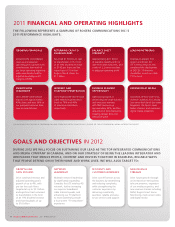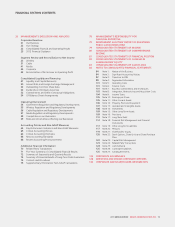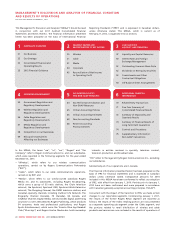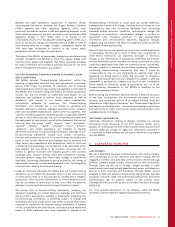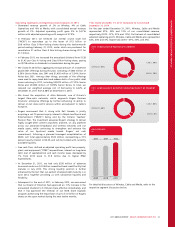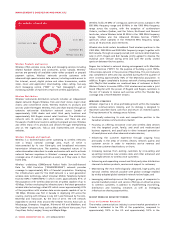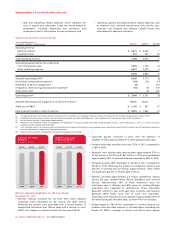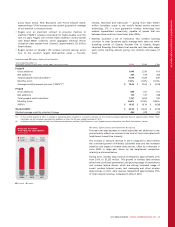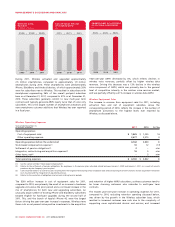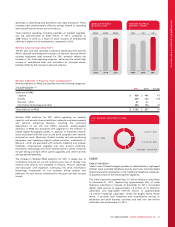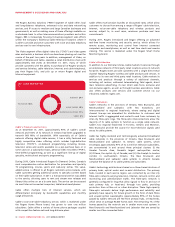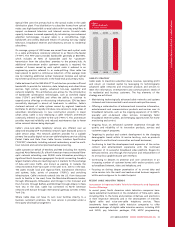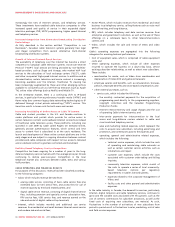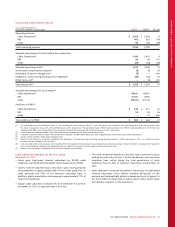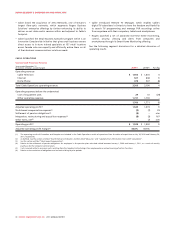Rogers 2011 Annual Report Download - page 30
Download and view the complete annual report
Please find page 30 of the 2011 Rogers annual report below. You can navigate through the pages in the report by either clicking on the pages listed below, or by using the keyword search tool below to find specific information within the annual report.
MANAGEMENT’S DISCUSSION AND ANALYSIS
(%)
2011 WIRELESS REVENUE MIX
POSTPAID VOICE 56%
DATA 33%
PREPAID VOICE 3%
EQUIPMENT 8%
Wireless Products and Services
Wireless offers wireless voice, data and messaging services including
related handset devices and accessories, across Canada. Wireless’
services are generally all available under either postpaid or prepaid
payment options. Wireless’ networks provide customers with
advanced high-speed wireless data services, including mobile access to
the Internet, e-mail, digital picture and video transmission, mobile
video, music and application downloading, video calling, two-way
short messaging service (“SMS” or “text messaging”), and an
increasing number of machine-to-machine wireless applications.
Wireless Distribution
Wireless’ nationwide distribution network includes: an independent
dealer network; Rogers Wireless, Fido and chatr stores; major retail
chains; and convenience stores. Wireless markets its products and
services under the Rogers Wireless, Fido and chatr brands through an
extensive nationwide distribution network across Canada of
approximately 3,400 dealer and retail third party locations and
approximately 360 Rogers owned retail locations. The distribution
network sells its service plans and devices, and there are also
thousands of additional locations selling its prepaid services. Wireless
also offers many of its products and services through telemarketing
and on the rogers.com, fido.ca and chatrwireless.com e-business
websites.
Wireless Networks and Spectrum
Wireless is a facilities-based carrier operating its wireless networks
over a broad, national coverage area, much of which is
interconnected by its own fibre-optic and broadband microwave
transmission infrastructure. The seamless, integrated nature of its
networks enables subscribers to make and receive calls and to activate
network features anywhere in Wireless’ coverage area and in the
coverage area of roaming partners as easily as if they were in their
home area.
Wireless’ underlying GSM/General Packet Radio Service/Enhanced
Data for GSM Evolution (“GSM/GPRS/EDGE”) network provides
coverage to approximately 95% of Canada’s population. Overlaying
the infrastructure used for the GSM network is a next generation
wireless data technology called Universal Mobile Telephone System/
Evolved HSPA (“UMTS/HSPA+”) which covers approximately 91% of
the population with wireless data services at speeds capable of up to
42 Mbps. Further overlaying the infrastructure is the latest generation
wireless data technology called LTE which covers approximately 32%
of the population with wireless data service speeds capable of up to
150 Mbps. Wireless was first in Canada in deploying LTE across the
country, starting with Ottawa in July 2011 and followed by Toronto,
Montreal and Vancouver. By the end of 2011, the LTE network
expanded to several cities around the Greater Toronto Area such as
Mississauga, Brampton, Vaughan, Richmond Hill and Markham, and
the Greater Vancouver Area, such as West and North Vancouver, Port
Coquitlam, Delta, Langley, Surrey and Maple Ridge.
Wireless holds 25 MHz of contiguous spectrum across Canada in the
850 MHz frequency range and 60 MHz in the 1900 MHz frequency
range across the country, with the exception of southwestern
Ontario, northern Québec, and the Yukon, Northwest and Nunavut
territories, where Wireless holds 50 MHz in the 1900 MHz frequency
range. Wireless also has Advanced Wireless Services (“AWS”)
spectrum, which operates in the 1700/2100 MHz frequency range,
across all 10 provinces and 3 territories.
Wireless also holds certain broadband fixed wireless spectrum in the
2300 MHz, 2500 MHz and 3500 MHz frequency ranges, together with
Bell Canada, through an equally-owned joint venture called Inukshuk.
Late in 2011, Rogers and Bell Canada jointly agreed to dissolve the
Inukshuk joint venture during 2012 and split the jointly owned
spectrum between the two parties.
Rogers has initiated a network sharing arrangement with Manitoba
Telecom Services (“MTS”) for the purpose of building a joint HSPA+
3.5G wireless network in the province of Manitoba. This joint network
was completed in 2010 and was launched during the first quarter of
2011 covering approximately 96% of the Manitoba population. In
addition, Rogers completed a business network sharing arrangement
with TBayTel that enables our combined base of customers in North
Western Ontario to receive HSPA+ 3.5G wireless services under a joint
brand (TBayTel with the power of Rogers) and Rogers customers in
the rest of Canada to receive such services within the Thunder Bay
coverage area in North Western Ontario.
WIRELESS STRATEGY
Wireless’ objective is to drive profitable growth within the Canadian
wireless communications industry, and its strategy is designed to
maximize subscriber share, cash flow and return on invested capital.
The key elements of its strategy are as follows:
• Continually enhancing its scale and competitive position in the
Canadian wireless communications market;
• Focusing on offering innovative voice and wireless data services
into the targeted youth, family, and small and medium-sized
business segments, and specifically to drive increased penetration
of smartphones and other advanced wireless devices;
• Enhancing the customer experience through ongoing focus
principally in the areas of wireless devices, network quality and
customer service in order to maximize service revenue and
minimize customer deactivations, or churn;
• Increasing revenue from existing customers by cross-selling and
up-selling innovative new wireless data and other enhanced and
converged services to wireless voice customers;
• Enhancing and expanding owned and third party sales distribution
channels to deliver products, services and support to customers;
• Maintaining the most technologically advanced, high-quality and
national wireless network possible with global coverage enabled
by widely adopted global standard network technologies; and
• Leveraging relationships across the Rogers group of companies to
provide bundled product and service offerings at attractive prices
to common customers, in addition to implementing cross-selling,
distribution and branding initiatives as well as leveraging
infrastructure sharing opportunities.
RECENT WIRELESS INDUSTRY TRENDS
Focus on Customer Retention
The wireless communications industry’s current market penetration in
Canada is estimated to be 78% of the population, compared to
approximately 103% in the U.S. and approximately 122% in the
26 ROGERS COMMUNICATIONS INC. 2011 ANNUAL REPORT




